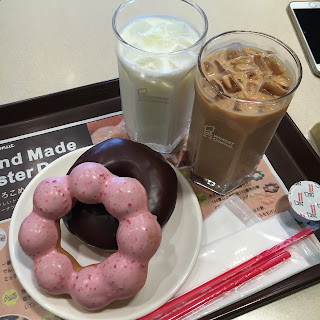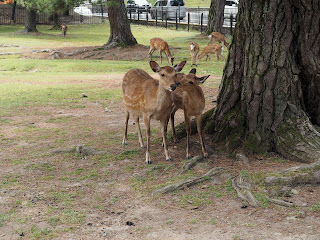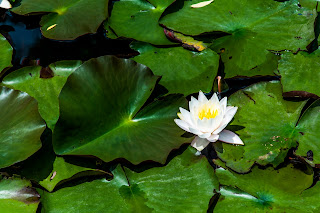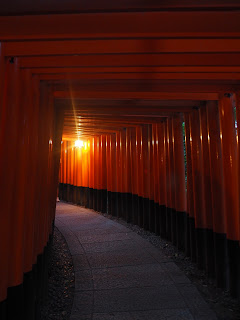In case you missed Day One Post click here.
If you need some advices for planning your next trip to Japan click here.
Se vi siete persi il post sul primo giorno cliccate qui.
Se avete bisogno di qualche consiglio su come pianificare il vostro prossimo viaggio in Giappone cliccate qui.
***
I still don't know how we managed to stay awake for all those hours, but doing so actually got us adjusted to the new time zone pretty fast.
We woke up early and we started organizing our second day in Kyoto with the Ryokan's wifi, since our sims still weren't working.
We used Hyperdia App that was extremely handy to check the trains' timetable, it quickly became essential for our trip.
We packed our backpacks and headed out. It was already 8.30 in the morning but the streets seemed almost empty. We met a kind Obaa-San (old lady/Gramma) who greeted us with an unexpected "Konnichiwa" (we could improperly translate it with "hello"), and made my heart melt.
This memory always brings a smile on my face every time I reminisce it.
Walking towards Kyoto Station, I spotted a colorful shop window full of a variety of donuts, so we decided to enter.
I must admit that we alsways had western style breakfast in the whole trip, 5 years ago I coudn't bare to have fish for breakfast, but thinking about it now I really regret it, so when (if?) I'll go back i'll definitively try it.
So we found out about Mr. Donut, a fast food chain specialized, of course, in donuts with a strong japanese kawaii factor.
Kawaii basically means cute, adorable and Japan is bursting with kawaii stuff, even a crush barrier could be shaped as Hello Kitty.
It won't come as a big surprise that I'm deeply fashinated by this style, that's why I ordered a strawberry Pon-de-ring and an iced latte, yummy, fresh and cute.
Essere riusciti a resistere tutte quelle ore per andare a dormire ad un orario normale, ha fatto si che il nostro bioritmo si adattasse perfettamente al nuovo fuso orario.
Ci siamo comunque svegliati presto e abbiamo iniziato a programmare la giornata utilizzando la wi-fi del Ryokan, visto che ancora non eravamo riusciti a far funzionare la sim.
Abbiamo utilizzato l'app di Hyperdia per calcolare tutti i nostri spostamenti col treno, uno strumento che si è rivelato indispensabile durante tutto il nostro viaggio.
Zaini in spalla e programma stabilito siamo usciti per fare colazione.
Anche se erano già le 8.30 non c'era quasi nessuno in giro, tranne una carinissima Obaa-San (nonnina) che ci ha salutato con un inaspettato "konnichiwa" (quello che potremmo considerare l'equivalente di ciao), cosa che mi ha stritolato il cuore e che ancora adesso ricordo con tenerezza.
Vicino alla stazione, da una vetrina, ho intravisto donuts di tutte le forme e colori possibili, così siamo entrati.
Se devo essere onesta, abbiamo sempre fatto colazioni "occidentali", cinque anni fa cominciare la giornata con del pesce mi sembrava impossibile, ripensandoci oggi mi sono pentita di non aver provato almeno una volta, quindi se e quando riuscirò a tornare, lo farò sicuramente.
Siamo quindi entrati da Mr. Donut, una catena di ristoranti fast food specializzata, appunto, nelle ciambelle americane, alla quale in pieno stile giapponese è stata aggiunta una forte dose di Kawaii.
Kawaii significa carino, adorabile, e il Giappone straripa di oggetti kawaii, persino una transenna può avere la forma di Hello Kitty.
Inutile dire che io sono stregata da questo stile, infatti ho scelto la ciambella rosa a pallini (gusto latte e fragola) con un iced latte, una colazione deliziosa, fresca e adorabile.
First stop of our second day in Japan was Nara.
With our JR Rail Pass and Hyperdia we easily caught the first rapid train.
Every train time table has both kanji and romanic alphabet, so it's very easy to understand.
Keep in mind that local trains have way more stops than express or rapid trains, and also that some locations are only served by local trains only. It all depends on how much time you have and how you enjoy traveling.
We got off in Nara, got the city map from the info point and went straight to Nara Park.
I wish I collected every station stamp, unfortunately we were so all over the place we managed to get only a few, in this case Nara's mascotte Shikamaru Kun.
I recommend you to take a small notebook with you to collect the stamps, it would be the perfect souvenir from you trip.
La prima tappa di questa seconda giornata è stata Nara, con il JR Rail Pass siamo siamo saliti sul primo treno rapido che abbiamo trovato, sempre grazie a Hyperdia.
Nei tabelloni luminosi troverete le informazioni anche nel nostro alfabeto, tenete presente però che i treni locali fanno molte più fermate rispetto ai treni rapidi o agli espressi, quindi tutto dipende dal tempo che avete a disposizione per il vostro viaggio e dalla meta che volete raggiungere, le stazioni più piccole spesso sono raggiunte solo dai treni locali.
Arrivati a Nara, abbiamo preso la mappa dal centro informazioni e ci siamo diretti verso il famosissimo Parco.
Avrei tanto voluto collezionare tutti i timbri delle stazioni dove siamo stati, ma la frenesia era tale che non abbiamo prestato molta attenzione a questi dettagli, quindi vi consiglio di partire con un quadernino dove raccogliere tutti i timbri dei posti che visiterete, diventerà un ricordo speciale.
Noi ci siamo limitati a qualche timbro, probabilmente per bambini, con la mascotte della città: Shikamaru Kun.
We walked through Sanjo Dori, this street is full of every kind of shop and if you explore all the little side streets you fill also find a huge variety of restaurants.
One shop in particular caught my attention, the Nippon-Ichi, the bright shop windows full of peculiar items lured us in.
We got some omiyage (souvenir) all deer themed, my favourite one is the Daruma.
We also spotted a gatcha-pon (capsule toy vending machine) with inside wooden miniature toys from different prefectures.
Abbiamo percorso la Sanjo Dori, una strada ricca di negozi di vario genere dalla quale si diramano altre stradine piene di ristoranti.
Un negozio in particolare mi ha colpito, il Nippon-Ichi, grazie ai suoi interni molto luminosi e agli oggetti particolari esposti in vetrina.
Abbiamo acquistato alcuni omiyage (souvenir) a tematica cervi, la mia preferita è sicuramente la Daruma.
Abbiamo anche trovato un gacha-pon con all'interno miniature di antichi giocattoli in legno tipici di varie prefetture.
We finally arrived at the park and we had our first surreal encounter with all the deers that roam freely around, there were so many!
They usually bow to ask you for food, you can find stands that sell crackers, don't feed them with anything else.
Please remember that these animals are wild, so double check your pockets, bags and your possession in general, because they tend to pick food directly from the "source".
We obviously spent a ridiculous amount of time with the deers, feeding them, taking pictures.
Since we live in Bologna city center we don't have the chance to interact with nature that often, maybe that's why it took us forever to move on.
Arrivare al parco e ritrovarsi in mezzo ai cervi liberi è stato surreale, erano davvero tantissimi!
Sono anche abituati ad inchinarsi per avere qualcosa da mangiare, nel parco vendono questi biscotti/crackers fatti per loro, mi raccomando non dategli altre tipologie di cibo.
Vi consiglio di controllare, inoltre, le vostre borse e tasche, non lasciate nulla incustodito, perchè sono ormai così abituati alle persone che se intravedono qualcosa di commestibile lo prendono direttamente senza preavviso.
Inutile dire che abbiamo passeggiato in mezzo ai cervi per un tempo lunghissimo, scattando foto all'impazzata, per noi che viviamo in centro a Bologna questo tipo di contatto con la natura è molto raro, forse per questo non riuscivamo ad andare via.
We visited the Kofukuji temple, which is also renowned for its five stories Pagoda, that is the second highest Pagoda in Japan.
Exploring these sacred places it's quite an experience, you become in contact with a commistion of religions and tradition (buddhism and shinto) that acquired a certain level of fluidity over time.
At the entrance of this temple we were welcomed by various Jizo statues, a monk who protects travelers and children, you will find his statues everywhere.
Immersed in this commistion of buddhism and shinto, we found a fountain (typical of shinto shrines) that is used to purify hands and mouth before entering the sacred place.
You need take the ladle with your right hand , pick up some water, purify your left and and vice versa.
Then with your left hand you pick up some more water to purify your mouth.
This fountain shaped as a dragon was particularly beautiful.
Another typical element of shinto shrines is the rope with a bell attached, that is used by worshippers to announce their prayer to the Kami (deity).
Abbiamo visitato il complesso di templi del Kofukuji, famoso anche per la sua pagoda a 5 piani, la seconda per altezza in tutto il Giappone.
Visitare questi luoghi di culto è un'esperienza particolare, si percepisce una commistione di religioni (buddhismo e shintoismo) e di tradizioni che hanno acquistato col tempo una certa fluidità.
All'ingresso del complesso del Kofukuji siamo stati accolti da una serie di statuette che raffigurano Jizo, un monaco buddista protettore dei viaggiatori e dei bambini, che abbiamo ritrovato praticamente ovunque.
Sempre in questa commistione tra templi e santuari, prima di accedere al santuario (shintoista) bisogna purificarsi mani e bocca, troverete una fontana con lunghi mestoli di legno, questa a forma di drago era bellissima.
Se volete potete quindi utilizzare il mestolo con la mando destra per prendere un po' d'acqua e purificare la mano sinistra, fare lo stesso invertendo le mani e poi sempre con la sinistra prendere dell'acqua per pulire la bocca.
Altro elemento classico del santuario shintoista è il campanaccio legato ad una corda, che col suo suono saluta la divinità (Kami) prima della vostra preghiera.
Visiting these sacred places, you will find a variety of cult objects such as:
- Ema, small decorated wooden boards (it could also be of a different material), you write your wish or prayer on and then you hang it in the designed place, easy to find because it will be overflowing with them;
- Omamori, cute little embroidered charm, you will find a omamory for every thinkable necessity you may have, luck, love, money, health, even for passing an exam;
- Omikuji, these are basically predictions, you will pick a numbered stick from a box, that number will correspond to a prediction with a different grade of good or bad luck. usually if you get a bad luck prediction, you knot the omikuji to a specific place close to the shrine, in that way the bad luck will get stucked to that place and not to you.
Our curiosity won over our shyness, so we tried pretty much everything.
At the end of the day prayers can't hurt anyone, clearly everything must be done in the most respectful way.
Visitando questi luoghi sacri vi capiterà di trovare oggetti di culto, in particolare:
- Ema, tavolette votive di varie forme e decorazioni dove scrivere la vostra preghiera per poi appenderle nei luoghi preposti, che sono facili da riconoscere perchè strabordanti di questi oggetti votivi, in modo che le divinità possano leggerle ed eventualmente esaudirle;
- Omamori, piccoli porta fortuna ricamati, ce ne sono di specifici per ogni necessità, per avere fortuna in amore, per la buona salute, per passare un esame etc.;
- Omikuji, sono biglietti che contengono una predizione, si estrae un bastoncino numerato da una scatola di legno, a quel numero corrisponde la predizione che può essere di vari gradi di fortuna o sfortuna. Solitamente se esce una predizione sfortunata si lega il foglietto ad un albero del santuario in modo che la sfortuna si leghi all'albero piuttosto che alla persona che ha ricevuto la predizione.
La curiosità ha vinto sulla timidezza, quindi abbiamo provato un po' di tutto.
Alla fine una preghiera in più nel mondo non può certo fare nulla di male, l'importante chiaramente è dimostrare rispetto per la sacralità di questi luoghi e per i loro rituali.
We walked thowards the Todaiji and in that precise moment we realized we were surrounded not only by deers but also by class on their school trip.
Watching all the school uniforms made me feel like in an anime and I remember laughing while thinking that for once reality was exactly like my imagination.
A ton of school trip anime episodes kept popping up in my mind, so I started looking for the typical manga characters in those groups of students: the popular guy with his clique of loud friends, the shy girls dealing with their first love, the diligent student who follows every teacher's word and explanation.
It's quite hard trying to collect and share my feelings about that situation, it felt like everything that belonged to my imagination was now real and tangible.
Ci siamo diretti, sempre a piedi, verso il Todaiji ed è stato in quel momento che ci siamo accorti di essere circondati non solo da cervi, ma da intere scolaresche.
A vedere tutte quelle divise scolastiche mi sono sentita catapultata in un anime e mi è venuto da ridere pensando che in questo caso la fantasia collimava con la realtà.
Mi sono tornati in mente mille episodi di gite scolastiche e ho iniziato a cercare i loro classici protagonisti, il ragazzo popolare con i suoi amici un po' sguaiati, le ragazze timide alle prese con la prima cotta che ridacchiano sotto i baffi, lo studente serio che segue il maestro e non perde nemmeno una parola di ogni sua spiegazione.
E' difficile inquadrare i miei pensieri e le mie emozioni di allora, tutto quello che fino a quel momento era stato una proiezione della mia fantasia per la prima volta diventava tangibile e reale.
What has really stuck with me about the Todaiji Temple is its magnificence for sure, which is expressed by its architectural structure, the two impressive wooden statues of the two Buddha's guardians in the Nandaimon (Great South Gate) and the majestic Daibutsu, the bronze Buddha statue.
Inside the great hall you will also find a pillar with a hole at its base, that is said to be large as one Buddha's nostril. If you manage to pass through the whole you should have granted illumination for you next reincarnation.
As you can see from the pictures, only the children were brave enough to try it!
Quello che mi è rimasto più impresso del tempio Todaiji è sicuramente la sua imponenza, che si esprime nella sua struttura architettonica, nelle due grandi sculture lignee dei guardiani del Buddha poste nel Nandaimon (Grande Porta Sud) e nel Daibutsu, la maestosa statua bronzea del Buddha.
All'interno si trova anche una colonna con un foro si dice della stessa grandezza di una narice del Buddha.
Riuscire a passarci attraverso garantirebbe l'illuminazione nella prossima reincarnazione, ma, come vedete dalle foto, solo i bambini erano abbastanza coraggiosi da provarci!
Next stop the Nigatsu-do, a smaller temple situated on a hill that offers a pleasant view of the park and the city.
This temple is famous for Omizutori, a buddhist ceremony that takes place every year on March the 14th, with a night parade of inflamed torches.
Subito dopo ci siamo diretti al Nigatsu-do, un tempio di dimensioni più contenute che grazie alla sua posizione offre una piacevole vista del parco e di Nara.
Questo tempio è famoso per l'Omizutori, una festa buddhista che si tiene ogni anno il 14 marzo, caratterizzata da una cerimonia notturna con fiaccole infuocate.
Before we left Nara Park, we headed to the Kasuga Taisha Shrine, recognizable for his vermillion structure and the multitude of lanterns.
These laterns are enlighted twice a year for the Mandoro, the lantern festival of which you can have a sneak peek in one of the inner halls where you can find a few enlighted lanterns. I'm sure the festival though is breathtaking, I hope I will be able to see it sooner or later!
Every 20 years the shrine gets a special make over, with the Shikinen Zotai ceremony that provides a strict catalogue of rules and tradition to preserve Kasuga Taisha incredible beauty over time.
Prima di lasciare il parco di Nara, abbiamo visitato il santuario Kasuga Taisha, riconoscibile per la sua struttura rosso-arancione brillante e per la distesa di lanterne appese.
Le lanterne vengono accese due volte all'anno per il Mandoro, di cui potete avere un "assaggio" in una delle sale interne dove sono state collocate alcune lanterne accese, ma immagino che il vero festival sia qualcosa di spettacolare e spero di potervi partecipare prima o poi!
Ogni vent'anni, con la cerimonia dello Shikinen Zotai, vengono fatte tutte le riparazioni necessarie al santuario, secondo le regole rigide della tradizione, in modo che mantenga sempre la sua incredibile bellezza.
Hurrying up through Sanjo Dori to Nara Train Station, we spotted a peculiar person who seemed us quite surreal due to the context.
He probably was just a monk, but seeing him in that pose, under that singular sculpture, that in my mind seemed floating on his head thanks to unimaginable powers, made me feel like in a videogame.
Affrettandoci verso la stazione di Nara, ripercorrendo la Sanjo Dori, ad un semaforo abbiamo incontrato questo personaggio a dir poco surreale in quel contesto.
Si trattava probabilmente di un semplice monaco, ma vederlo così in quella posa, sotto quella particolare scultura, che nella mia immaginazione sembrava fluttuare sopra la sua testa grazie a chissà quali poteri, mi ha fatto sentire come in un videogame.
We took another local train to Uji. This wasn't on our must visit list, but the kind lady at the ryokan recommended it to us, and this suggestion revealed to be absolutely precious.
Main Uji's attraction is the Byodoin Temple, possibly my favourite one in this trip.
You can also find a reproduction of this temple on the 10 Yen coin.
Since it was already 5 o'clock they let us in, but we were only able to see the Byodoin from the outside, everything else like the phoenix room, the museum, the tea shop sadly were already closed, keep in mind that most of museums and historic sites close at 5 p.m.
Siamo risaliti su di un treno locale per arrivare a Uji, questa tappa fuori programma ci era stata consigliata la mattina presto da una gentile signora dello staff del Ryokan ed è stato un suggerimento preziosissimo.
A Uji si trova il tempio Byodoin, forse uno tra i miei preferiti tra quelli visitati in questo viaggio in Giappone.
E' il tempio che trovate anche sul retro della moneta da 10 Yen.
Essendo arrivati alle 5 del pomeriggio, all'ingresso ci hanno fatto capire che era quasi tutto chiuso, in particolare la sala della Fenice, il museo e la sala da te, quindi mi raccomando ricordatevi di andarci prima delle 5.
Uji is also renowned for its tea plantations, matcha in particular is very popular and it quickly became trendy even here.
You definitively experience that ancient atmosphere even here, while walking on an ancient bridge crossing Ujigawa river, where you can see cormorants fishing.
At the end of the bridge we were welcomed by Murasaki Shibiku statue, author of Genji Monogatari.
If you take the Byodoin Omotesando, you will find countless stores that sells every kind of tea, traditional (wagashi) and modern sweets and desserts, souvenirs.
We decided to stop at Tsuen, the oldest tea shop in Uji, which is also supposed to be the oldest in whole Japan.
We were very late and if I remember correctly we managed to sneak in to buy some tea. All the shop assistant were clearly confused, maybe upset, and rightly so! Please do not repeat our silly mistakes!
Uji è rinomata anche per il the, il matcha in particolare, che negli ultimi anni è diventato popolarissimo anche da noi.
Si respira anche qui un'atmosfera storica, attraversando l'Ujigawa su di un antico ponte da cui si possono vedere i cormorani pescare tuffandosi nel fiume.
Alla fine del ponte ci accoglie la statua di Murasaki Shibiku, autrice del Genji Monogatari.
Percorrendo la Byodoin Omotesando troverete innumerevoli botteghe che vendono the, dolci tradizionali (wagashi) e moderni e souvenir.
Noi ci siamo fermati a quello che dovrebbe essere il negozio di the più antico di Uji e addirittura del Giappone. Tsuen.
Anche in questo caso siamo arrivati tardi e se la memoria non mi inganna ci siamo addirittura intrufolati per comprare del the. I commessi erano abbastanza seccati, come dargli torto! Non seguite il nostro esempio!
Last but certainly not least on our second day itinerary the Fushimi Inari Taisha, one of the most renowned shrine in all Japan, represented by its long paths of red Tori (gates).
Normally it's jam packed with tourists, but since we arrived there quite late we had the place almost all for ourself.
Unfortunately everything was closed, but walking through the tori gates in the silence of the sunset was so peaceful and evocative.
We were too tired to hike to the top of the trail, but I know the view from there is stunning.
Ultima immancabile tappa della giornata il Fushimi Inari Taisha, uno dei santuari shintoisti più famosi del Giappone, caratterizzato da un lungo percorso di Tori (portale, porta) rossi.
Solitamente è assalito dai turisti, ma vista l'ora tarda ci siamo trovati in pochissimi a visitare il santuario.
Purtroppo era tutto chiuso, ma è stato comunque suggestivo visitare questo luogo, solitamente gremito di gente, nel silenzio mentre il sole tramontava.
Eravamo troppo stanchi per percorrere tutto il sentiero fino in cima e quindi ci siamo fermati più o meno a metà, vi consiglio di proseguire fino alla cima per godere di un bellissimo panorama.
At the end of this intensive day, full of history, culture, deers and trains, we realized that during this frantic marathon we completely forgot to eat.
We got back in Kyoto when it was already dark, we decided to walk to the city centre and after a few kilometers we had Okonomiyaki (savory "pancake" that you can dress with pretty much anything you want, bacon, sea food, shrimps cheese etc.) at Nishiki Warai.
Usually they put Katsuobushi (bonito flakes) on top of okonomiyaki and they seem to move due to the food heat.
We also ordered some Gyoza, pork and cabbage ravioli usually cooked in a pan.
We enjoyed eating it so much that we ordered 3 times, the staff was very happily surprised about it so they gave us one order for free but they served it with the bill. so we still have to figure out what happened.
In the meanwhile we finally managed to make the mobile sim work, thanks to my brother in law Matteo that helped us videocalling from Italy.
That's how our second day in Japan ended, I'll keep posting about our wonderful trip, so stick around!
Dopo una giornata così intensa, tra storia, cultura, cervi e treni, ci siamo resi conto che nella smania di vedere quanto più possibile ci siamo dimenticati di mangiare.
Tornati col buio a Kyoto ci siamo diretti, sempre a piedi, verso il centro e, dopo qualche chilometro, ci siamo fermati al Nishiki Warai dove abbiamo provato finalmente una vera Okonomyaki, quella che potremmo definire una frittata di cavolo che può essere condita a vostro piacimento, con pancetta, frutti di mare, gamberi, formaggio e chi più ne ha più ne metta.
Solitamente sopra si aggiungono scaglie di Katsuobushi, o Bonito, cioè tonno essiccato, che col calore sembrano muoversi.
Abbiamo anche ordinato dei Gyoza, ravioli ripieni di carne e verdura cotti solitamente in padella.
Ci sono piaciuti talmente tanto che ne abbiamo ordinati 3 piatti, i commessi del locale erano così divertiti che ce ne hanno portato un altro in regalo servendolo però insieme al conto, quindi non abbiamo ben capito la situazione.
Nel mentre siamo riusciti a risolvere il problema della sim grazie a mio cognato Matteo che dall'Italia ci ha spiegato come fare.
Finisce così la nostra seconda giornata in Giappone, continuerò a pubblicare post del nostro viaggio quindi restate nei paraggi!












































































































